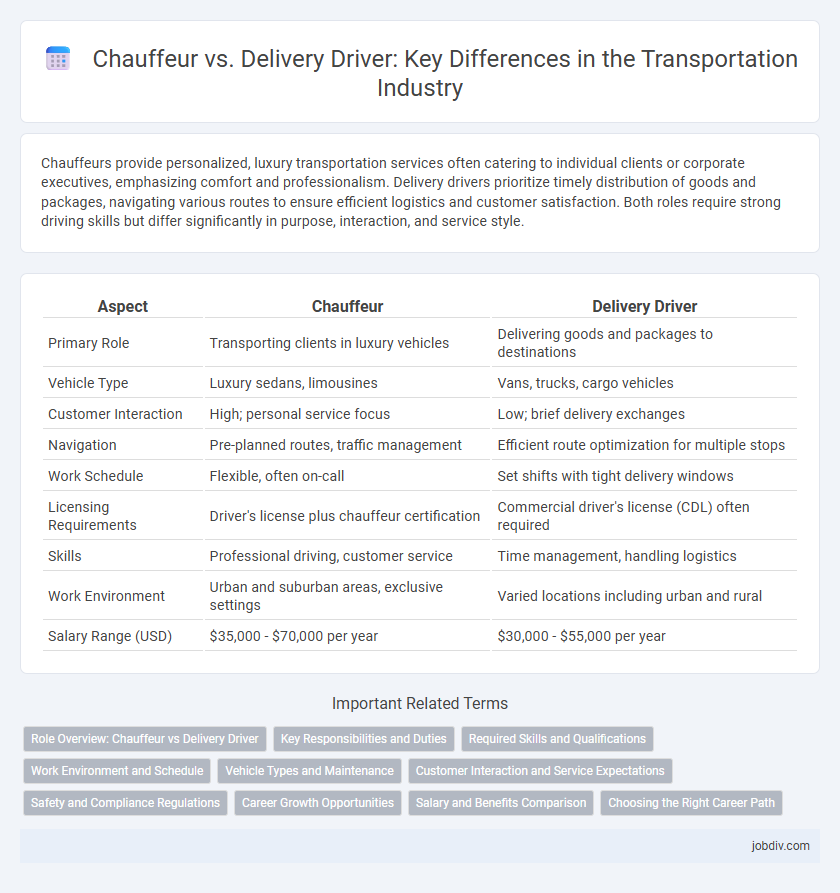Chauffeurs provide personalized, luxury transportation services often catering to individual clients or corporate executives, emphasizing comfort and professionalism. Delivery drivers prioritize timely distribution of goods and packages, navigating various routes to ensure efficient logistics and customer satisfaction. Both roles require strong driving skills but differ significantly in purpose, interaction, and service style.
Table of Comparison
| Aspect | Chauffeur | Delivery Driver |
|---|---|---|
| Primary Role | Transporting clients in luxury vehicles | Delivering goods and packages to destinations |
| Vehicle Type | Luxury sedans, limousines | Vans, trucks, cargo vehicles |
| Customer Interaction | High; personal service focus | Low; brief delivery exchanges |
| Navigation | Pre-planned routes, traffic management | Efficient route optimization for multiple stops |
| Work Schedule | Flexible, often on-call | Set shifts with tight delivery windows |
| Licensing Requirements | Driver's license plus chauffeur certification | Commercial driver's license (CDL) often required |
| Skills | Professional driving, customer service | Time management, handling logistics |
| Work Environment | Urban and suburban areas, exclusive settings | Varied locations including urban and rural |
| Salary Range (USD) | $35,000 - $70,000 per year | $30,000 - $55,000 per year |
Role Overview: Chauffeur vs Delivery Driver
A chauffeur provides personalized, luxury transportation services, often driving private clients, executives, or celebrities in high-end vehicles while ensuring comfort, safety, and discretion. A delivery driver focuses on transporting goods, packages, or food from distribution centers to customers efficiently and on time, navigating various routes and handling logistics. Both roles require driving skills and knowledge of traffic regulations but differ significantly in customer interaction and job responsibilities.
Key Responsibilities and Duties
Chauffeurs are responsible for providing luxury transportation services, ensuring passenger comfort, safety, and punctuality while often managing vehicle maintenance and route planning for private clients or executives. Delivery drivers focus on the timely and accurate transportation of goods, handling loading and unloading, verifying delivery information, and maintaining product condition during transit. Both roles demand strong navigation skills and adherence to traffic laws, but chauffeurs emphasize personalized service whereas delivery drivers prioritize efficiency and logistics management.
Required Skills and Qualifications
Chauffeurs require advanced driving skills, knowledge of luxury vehicle maintenance, and strong customer service abilities tailored for personalized passenger experiences. Delivery drivers must demonstrate efficient route planning, time management skills, and basic vehicle operation proficiency, often holding a commercial driver's license depending on cargo type. Both roles demand a clean driving record, adherence to safety regulations, and reliability for consistent job performance.
Work Environment and Schedule
Chauffeurs typically work in luxury or corporate settings, providing personalized transportation services with flexible schedules that often include evenings and weekends. Delivery drivers operate in fast-paced environments such as warehouses or urban routes, adhering to strict deadlines and shift patterns that may require early mornings or late nights. Both roles demand adaptability, but chauffeurs emphasize client interaction, while delivery drivers focus on efficient package handling and route optimization.
Vehicle Types and Maintenance
Chauffeurs typically operate luxury sedans, limousines, or high-end SUVs designed for passenger comfort and prestige, requiring meticulous maintenance to ensure a flawless, professional experience. Delivery drivers frequently use light commercial vehicles, vans, or trucks optimized for cargo capacity and durability, emphasizing routine maintenance to prevent breakdowns and ensure timely deliveries. Proper vehicle upkeep in both roles minimizes downtime and enhances safety, tailored respectively to passenger transport or freight handling requirements.
Customer Interaction and Service Expectations
Chauffeurs prioritize personalized customer interaction, offering tailored services such as assisting with luggage and ensuring a comfortable, professional experience. Delivery drivers focus on efficiency and timely parcel drop-offs, with limited direct customer engagement beyond confirming receipt. Service expectations for chauffeurs include discretion, reliability, and premium care, while delivery drivers are expected to provide promptness, accuracy, and basic courteous communication.
Safety and Compliance Regulations
Chauffeurs must adhere to strict safety protocols and licensing requirements, including background checks and specialized training to ensure passenger safety. Delivery drivers follow regulations focused on cargo security and timely transportation while complying with vehicle weight limits and hours-of-service rules to prevent fatigue-related accidents. Both roles require ongoing compliance with local and federal transportation laws to maintain operational safety and legal standards.
Career Growth Opportunities
Chauffeurs typically enjoy career growth opportunities through specialized luxury or executive driving services, often leading to roles in private security or fleet management. Delivery drivers have diverse advancement paths in logistics, including route planning, warehouse supervision, and managerial positions within transportation companies. Both careers require specific skill sets, but delivery driving generally offers broader pathways due to the expanding e-commerce industry.
Salary and Benefits Comparison
Chauffeurs typically earn higher salaries than delivery drivers, with average annual pay ranging from $45,000 to $70,000 compared to delivery drivers' $30,000 to $50,000. Chauffeurs often receive additional benefits such as health insurance, retirement plans, and performance bonuses, reflecting their specialized skills and client-facing responsibilities. Delivery drivers may have fewer benefits but often gain overtime pay and flexible work hours depending on the employer and industry.
Choosing the Right Career Path
Choosing between a chauffeur and a delivery driver career depends on individual preferences for customer interaction and driving environments. Chauffeurs typically provide personalized, luxury transportation services requiring professionalism and a polished appearance, while delivery drivers focus on timely, efficient package or food delivery, often covering diverse routes. Evaluating factors such as work schedule flexibility, physical demands, and income potential helps determine the ideal transportation career path.
Chauffeur vs Delivery Driver Infographic

 jobdiv.com
jobdiv.com